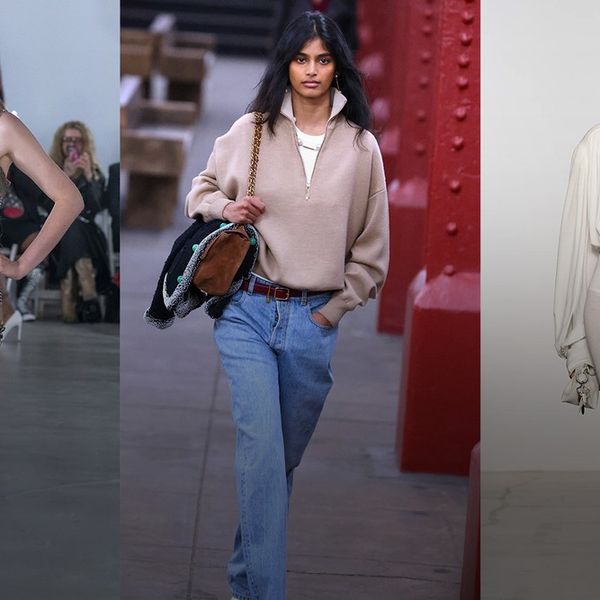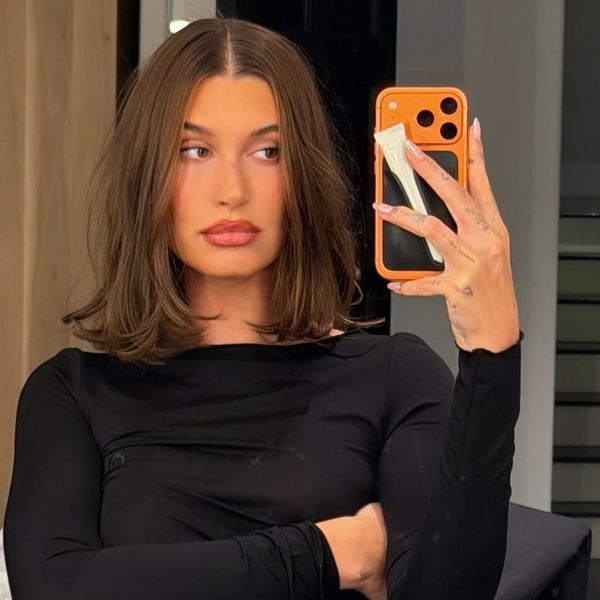The Various Stages of A Decaying Apple Inspired the Color Palette of Poor Things’ Costumes
Costume designer Holly Waddington had a license to be historically inaccurate.
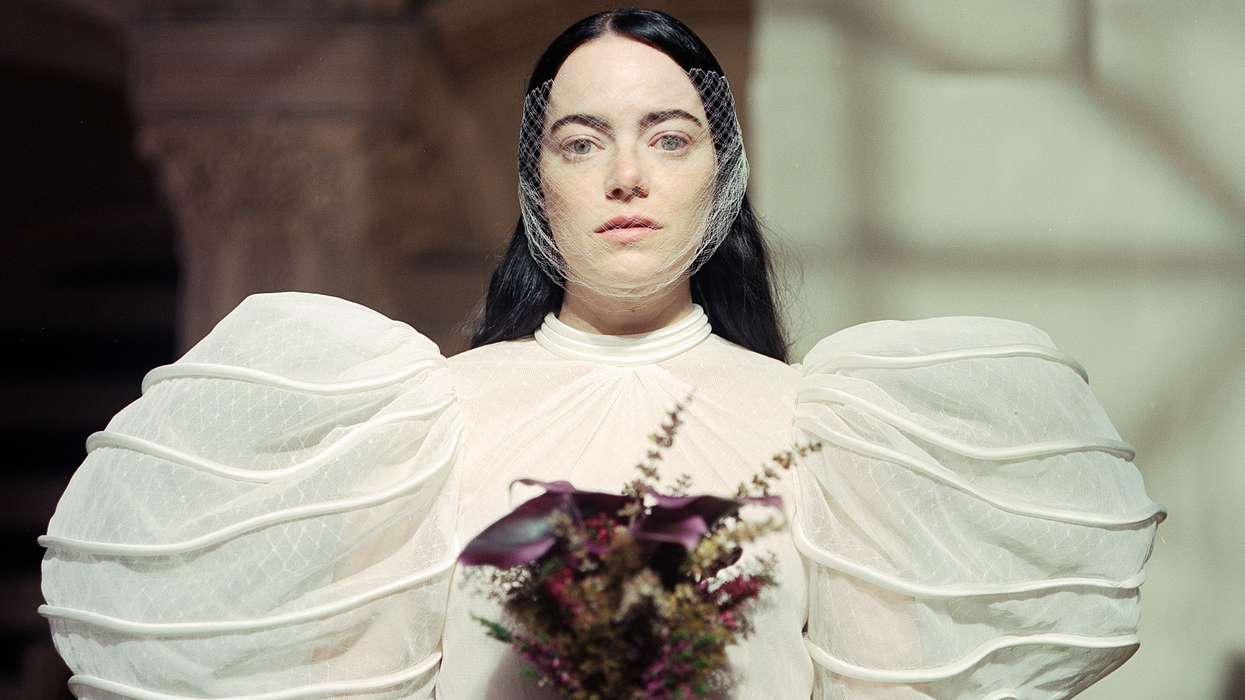
A tentpole of costume designer Holly Waddington’s approach to Poor Things, set somewhere vaguely near the turn of the 19th century, was the elimination of corsetry. “If you're doing Victorian dress but you don't have a corset, it won't look Victorian,” Waddington delineates. “It would've been boring to have them all in corsets. It's a piece of bondage.” Protagonist Bella Baxter, played by Emma Stone, waddles around (thanks to her baby brain) in various states of dress. “I never felt like she was experimenting with fashion,” explains Waddington. Instead, the ensembles result from a child rooting around in a suitcase full of sartorial possibilities sans societal expectations—and the know-how to adhere them to herself.
Bella may claim fault for the mishmash of undergarments and outerwear, but the surrealist clash of periods lies with the costume designer. Director Yorgos Lanthimos gave her a license to be historically inaccurate, one he prefers to operate with, as well. Bella donned knickers in the style of the 1930, a pair of ‘60s boots laced in the Victorian manner, and essentially an 1890s ruffled dickie meant to be an undergarment. Set against a backdrop of shockingly violent clouds, chartreuse stucco, and tufted velvet floors, the setting is manufactured and adulterated with flair and bombacity.
In this film, where aesthetic indulgence rivals quick wit and cultural commentary, color played its own role. “I suggested all of these colors that came from the body…very pinky tones,” Waddington reflects. “[Yorgos] said, ‘Oh, you're talking about the colors of a rotten apple.’ And when I googled ‘rotten apple,’ the colors that came up informed everything I did.” She not only derived the palette from bodily hues, but the materials, as well. “The fabric buyers’ job was to look for fabrics that evoked surface textures of living creatures, the body, particularly the inside of the body, the organs, intestines—materials that almost feel like they're breathing.”
Lanthimos sprinkled humor throughout his melancholic, often bombastic plotline to the audience’s pleasure and, at times, chagrin. In parallel, Waddington found a way to imbibe costumes inspired by internal organs with an unexpected buoyancy. Leaving the Brooklyn theater with my 20-something friends, the girls started swapping plans to buy modern versions of those Victorian-esque knickers—a heady accomplishment. Ahead, Holly Waddington takes us through her and her “excellent” team’s approach to outfitting each character in the film, whether it’s a boiler suit inspired by German expressionists or bodices with extremely exaggerated shoulders and exposed breasts.
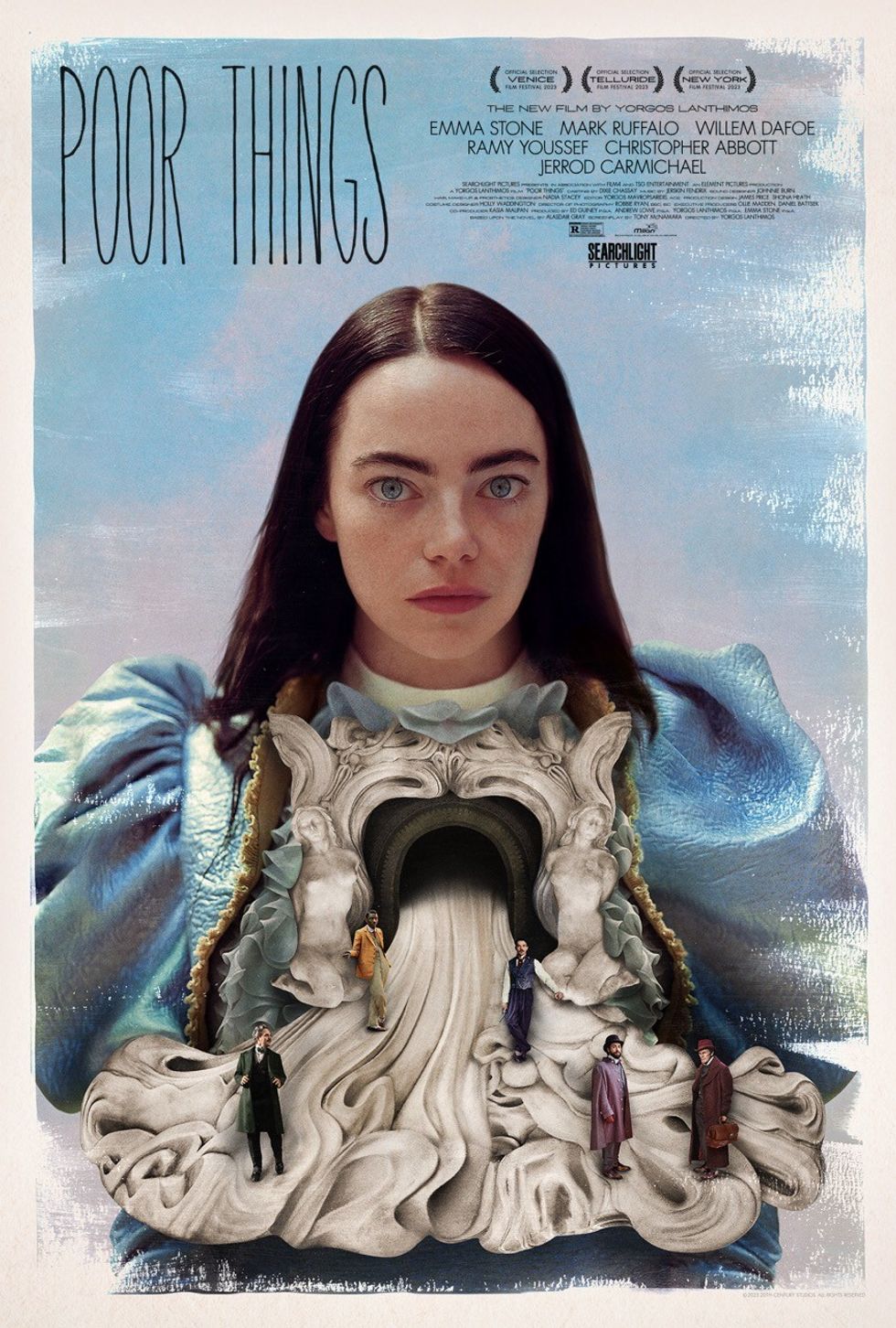
Photo: Courtesy of Searchlight Pictures.
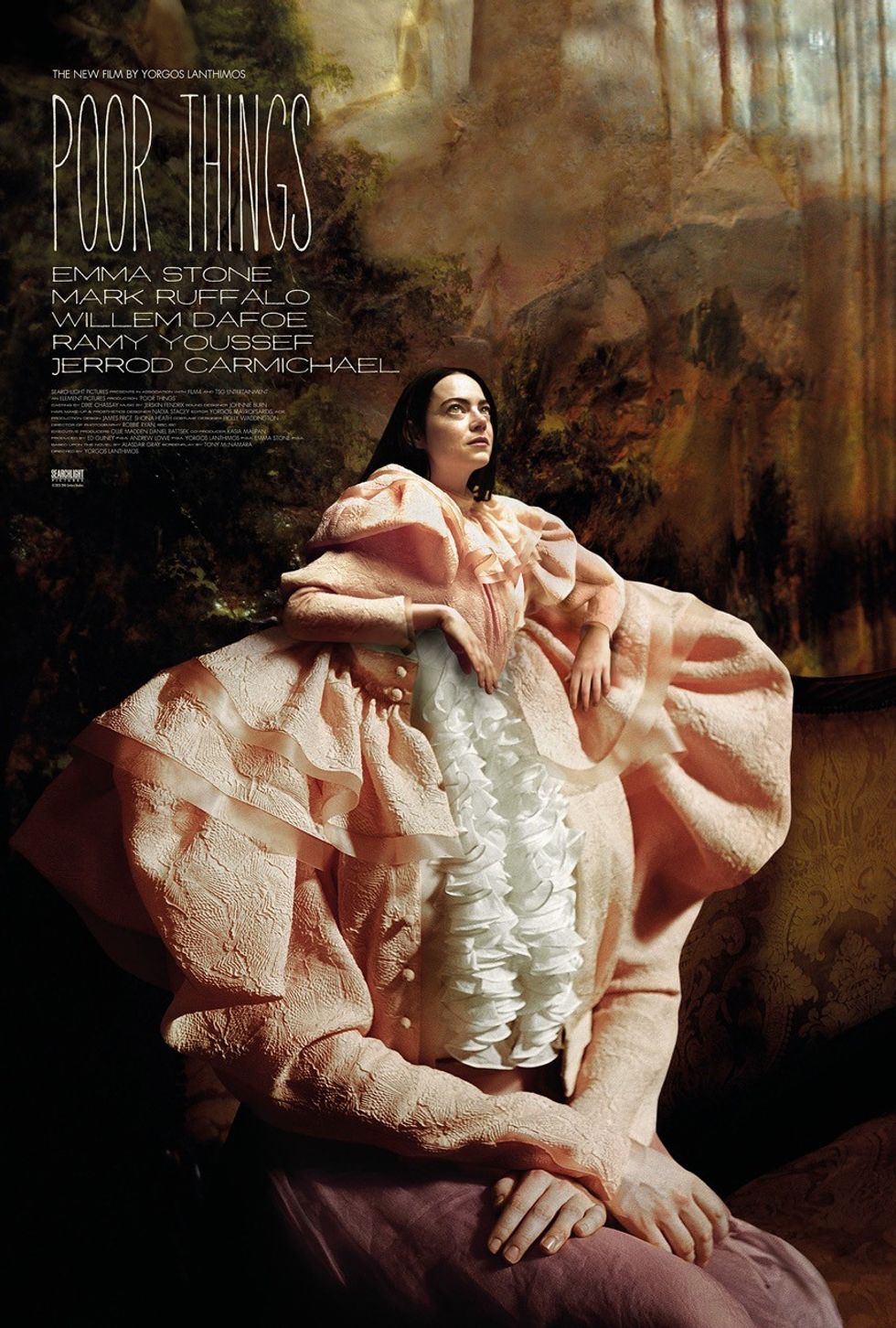
Photo: Courtesy of Searchlight Pictures.
When you first got the script, what did you feel? What did you see?
“I knew Tony McNamara wrote it, and I just love his work. (I had worked with Tony already on The Great.) I felt it was hilarious, really sort of subversive and funny and provocative. I loved it. I had also read the book. I knew I would have to work very hard to get the job; Tony had suggested me, but he could have worked with anyone, really. And it was all about her [Bella Baxter]. I saw these outfits that would be half-put-together. That was the thing that I stuck with. I also saw the whole thing in black and white, in my mind, but this was before we talked about colors and before I had the sense of how rich and spectacular he wanted the film to be because his work, the work that I'd seen before, apart from The Favourite, his work was quite minimal in aesthetic.”
I'd love to hear about how you guys approached color because it almost plays a character in the movie. I'm sure you had many conversations with many different departments. Did you get a preset color for each scene? How did it characterize the journey of the movie? Did you design into specific colors, or did they come after? What role did it play in your work?
“I was very much responding to what the art department was doing. They had been on board well before I got on board. I remember talking to Yorgos early on about colors for the beginning of the film, and I suggested all of these colors that came from the body. Shona [Heath] and James [Price] were doing the set design, and they were looking at these anatomical drawings. And often the colors, the way they're printed, are quite dusty—these dusty bodily pinks. Shona would say, ‘yucky colors, like off colors.’ I think that was the starting point for the house. When I talked to Yorgos about the colors I felt I would like to use in the costumes, I wanted to work with these very pink tones. When I described these colors to him, he said, ‘Oh, you're talking about the colors of a rotten apple.’ And when I googled ‘rotten apple,’ the colors that came up informed everything I did.
“Basically, I had charts, a huge board with pictures of decomposing apples, because depending on the stage of the apple, you've got all these rich tones. You've got the going-brown colors. On a green apple, you've got these almost acid yellows—A whole spectrum of pinks And the fact that he had come up with this in the moment says something about how incredibly nuanced his visual sense is. I also think it was interesting that he suggested that because, actually, she is like this apple decomposing. There's something very poetic about him saying that that really stuck with me. “

Photo: Yorgos Lanthimos; courtesy of Searchlight Pictures.

Photo: Yorgos Lanthimos; courtesy of Searchlight Pictures.
What about the colors for Bella specifically?
“I knew Lisbon would be a spectacular explosion of glorious technicolor. That's when she first sees the world. I responded very much to the spaces, which are almost like the colors of sugared almonds, very pastel. I wanted to use yellow for Bella because it was Yorgos's idea to have this long black hair. (It was based on this Egon Schiele drawing they'd found of this young woman with this ridiculously long hair.) The black hair and the yellow, these are nature's warning colors. These are the colors of bees, wasps, and caution tape. She is somebody who cannot be ignored.
“Then, Paris is this very black-and white world, very monochrome, with these beautiful red trees that Shona and James came up with. It's all very carefully plotted.”
Listening to interviews you've done, you talk so much about the shift from Bella being dressed by someone else to Bella dressing herself and what that leads to. I would love to hear about your journey constructing that story for her.
“The hardest part of designing Poor Things was working out what Bella would wear and how the clothes would move and change. And that was constantly changing and evolving, even down to the wire. The film’s opening was supposed to be her at the piano, but that changed and we got the blue dress [Victoria Blessington wears]. I had a big binder—a big, huge thing. It had chapters, and on each page, I had all my references for each costume,the drawings, and then the scenes that she would wear the costumes in. It was really complex to work it all out. That helped me fathom it.”
What it was like to deconstruct these historical garments and find the pieces you were going to play with in this equation?
“We were in the pandemic when I was doing Poor Things. I was told that I wouldn't be able to see the actors until about two weeks before the shoot, and I knew that that wouldn't work for Emma Stone's character, Bella Baxter, so I really pushed to meet her. And they arranged for me to go and meet her in Athens, where Yorgos lives, about ten weeks before we started filming. I had worked out a kind of dressing-up box. What would she need? I know I need a dressing gown and some pajamas. I need an apron because she's going to spill food all over herself.
“I liked this idea that we would see all the underpinnings you don't normally see, that create the silhouettes. The bustle, that funny tail, is the Victorian bustle. We don't see the padding, but I chose to show it. I brought six huge suitcases and flew out to meet Emma in Athens. It was through that fitting,trying things on,that I was able to find the pieces that we would use. For example, I learned that the sleeves needed to be huge and that we would use these 1930s knickers, or tap pants, as you Americans call them. I then went back to Budapest and drew it all up into costume designs.”

Photo: Courtesy of Searchlight Pictures.
You are constructing these stories about the garments for yourself.I read that you said Baxter would purchase them for Bella. Are those mainly for you? Or do you find that actors like hearing that to help build their relationship with their character and their clothes?
“I think most actors want to find logic in their thinking. It's important to most actors that they understand, ‘Why is my wedding dress like this?’ Or, ‘If I've got this evening dress on and it's all properly fastened up, why is it properly fastened up?’ These are the things I would talk to the actors about. Now, interestingly, Yorgo isn’t interested in that. He doesn't care about the logic. Part of the reason I think that his work is so absurd, interesting, and surprising is because he's not striving for this logic that most people want. One needs some limit, otherwise you can do anything. I need some framework. I had to make a story up for myself so that I could make decisions.”
Did the surrealist landscape give you license to be historically inaccurate? Was it nice to be able to mix everything up?
“I naturally like to do that anyway. I love surrealism. I like collaging things together, but I'm not a purist. I do know a lot about historical dress. I was a costumer for years in a costume house, and I've worked for lots of other designers on their projects, so I really know my stuff when it comes to period costume. What's really interesting is to play with a period t. [Set designer] Shona Heath is a born surrealist. The way she thinks and puts things together, she's always combining incongruous elements in a very interesting way. I think it's something that she does innately, and it was very liberating and interesting to do that.”
You said Jerrod had clothes from the '20s, whereas many of them were more 1890s-based. But were there any garments or ensembles in specific where you mix elements from different periods?
“Once Bella leaves home and goes to Lisbon, she wears pants that are 1930s, shoes that are riffing on a space age Andre Courreges boot from the '60s combined with a Victorian heel and lacing. And then there were many things that were extrapolated from a Victorian source, like this little frilly thing that she wears a lot. The Victorians liked to fill this space over the decolletage, as they called it. You would only have that body part exposed if it was evening. They filled that spacing with these little garments called fill-ins. In America you might call them a dickey, and she wears it on its own. Often the choice of fabric or the way that the thing is made was not very true to period,but then everything starts to take on its own life, in a way. “

Photo: Yorgos Lanthimos; courtesy of Searchlight Pictures.

Photo: Yorgos Lanthimos; courtesy of Searchlight Pictures.
It also seems like such a fascinating collage of artworks inspired you. You said German Expressionism for some of the men's costumes, and John Singer Sargent. Who are the artists and key works that informed this mishmash of styles?
“There are some paintings by Otto Dix and George Grosz, the modernist. They painted in these extremely vibrant colors. The things they were depicting were quite subversive. So often, there were women whose bodies were very naked. They're often probably prostitutes. I was very inspired by those artworks. John Singer Sergent was more about looking at actual clothes, how they're made, the shapes—less an emotional inspiration. I know that if Shona were here, she would say Hieronymus Bosch. I had a lot of photography on the board and pictures of people on cruise ships and in brothels.”
Tell me about designing costumes for a brothel because I feel like there's so much to inform that, and it's maybe a more delicate space to work in. What was that like?
“That was really interesting. I was pleased with the brothel. And the thing is, Poor Things was so intense. There were so many costumes. And it wasn't a massive long prep. We got to Hungary ten weeks before, and it was just flat-out making, designing, making, fitting. The brothel scene was filmed quite late in the process, a couple of weeks before the end of the shoot. So I put it off. And Yorgos would say, ‘What are we doing for the brothel?’ I had all of these references for Victorian brothels, which I think, even if you haven't studied the look of a Victorian brothel, we probably would all know what that would look like. Women wearing corsets and stockings and quite sexy knee boots—the core ingredients of clothes that we associate with pornography or the sex industry. The color palette is often black and red, so I felt it would be interesting to actively work against all the things that we associate with sexy, awfully horny clothes.
“I went for a palette that had all to do with skin. The women in the brothel were all different shapes,sizes, and colors. I did everything in different shades of nude. We continued not to do the corset. It would've been boring to have them all in corsets. It's a piece of bondage. It's about forcing the body into a shape. We were celebrating these very different women with their very different body shapes. Instead of corseting them, we made a thing of exposing their breasts. All the women had these bodices with these big huge sleeves, but the breasts were exposed. And then my team made them all a pair of these little hot pants. They had a very deep V in the crotch that had lacing and were worn open so that you could see the pubic hair. In our culture, we don't want to see pubic hair. So we made a thing of seeing pubic hair.”
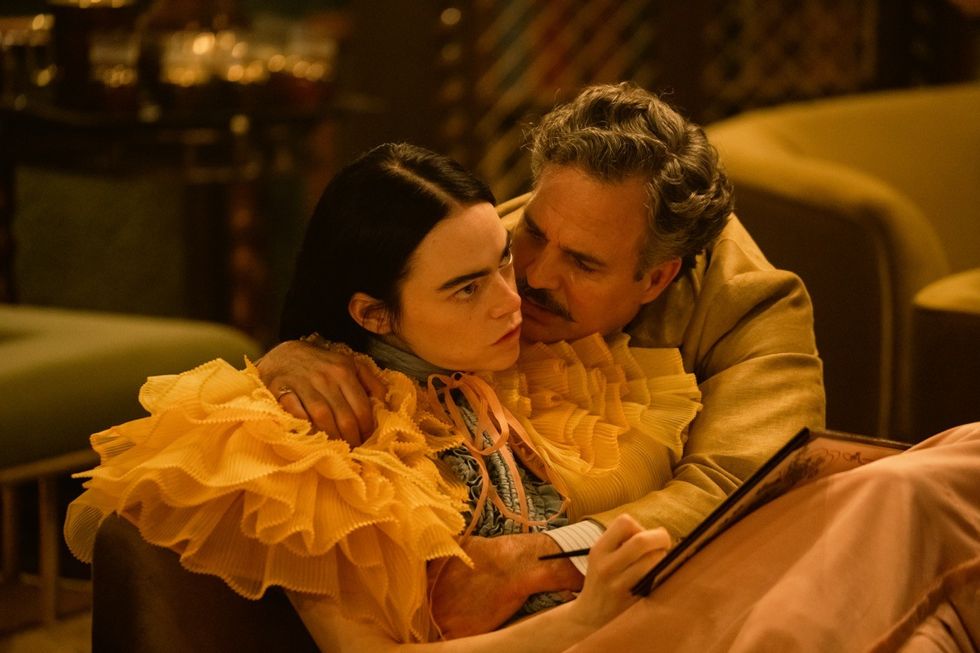
Photo: Atsushi Nishijima; courtesy of Searchlight Pictures.
I'd love to hear about, on the flip side, your approach to menswear, from the spectrum of the more clinical Baxter to Mark Ruffalo's more ornate character; how did you tackle those?
“I was working with the characters in mind. Mark Ruffalo's character was based on these satirical drawings of men that I was looking at, these hilarious cartoons you might see in the newspaper like Punch. These ruling-class British men looked so ridiculous in their pompousness. They have these postures with a very exaggerated puffed-out chest, a high imperial collar, and these big top hats. A curvy body shape was desirable, with these quite full thighs and calves. For years, men had these shirts that were almost down to their knees, and they would use the excess fabric to pad out their crotches, to give them a sort of embellished size. I wanted to play with all these things for Mark Ruffalo. So, lots of the stuff that we were doing to begin with was trying to create this sort of ridiculous silhouette. We went too far. It was too extreme at one point, so we had to reign it in.
“The thing that I like the most about Baxter’s costumes are these boiler suits he wears. He has about three of them, and they're like utility suits with places for his pens and surgical tools in the breast pocket. They were based on thinking about him being this very utilitarian man—he's a man of the future.The most futuristic elements are within Baxter's house, so they wear lots of plastic. They have plastic surgical scrubs. And Bella, when she was at home, had all of these plastic trimmings on her clothes.
“Max McCandles’s, played by Ramy, clothes are supposed to be a little bit impoverished. He's not from money. His suit is a bit wrong. It's a strange shape. He hasn't got a lot of sexual agency. He's a little bit diminished. He wears these little funny britches. He looks like a little boy.”
I want to hear about Bella's final ensemble because it's almost stark, in comparison to the rest of them, really modern. What were you thinking when you put that together?
“I felt it was important that by this point, she's just wearing clothes. We've seen her in all these guises and looks through different stages in her life. She was set on her intellectual journey by Harry and Martha on the boat, and then it was full steam ahead, and she discovered what she wanted to do with her life. She sees the slum. She wants to be a doctor. She's been through a lot, and she's arrived at herself. I never felt like she was experimenting with fashion. She's got this suitcase of clothes, and she's just putting the clothes on. Because of where she's at in the stage of development, the clothes are often put together in this very discordant way. By this point in the film, it's not about the clothes anymore because she's revising for her exams.
“She's wearing a jumper, but the jumper is actually taken from a historical reference, an 1890s knitwear photograph of this beautiful knitwear with these huge sleeves. We had a knitter copy it from a picture. It looks very modern. When I was in New York in September, in the Schiaparelli window, there was this jumper that almost looked the same
Want more stories like this?
The Science of Jewelry Stacking: Deskside with Jennie Yoon of Kinn Studio
How Much Would You Pay for Nicole Kidman’s Jumpsuit from The Iconic AMC Commercial?
Here in New York, Day-to-Night Style is Still A Thing

